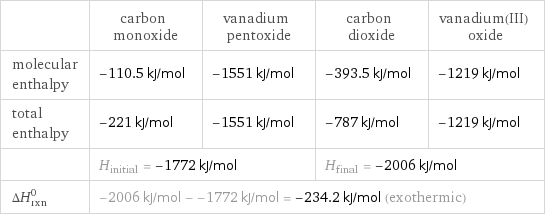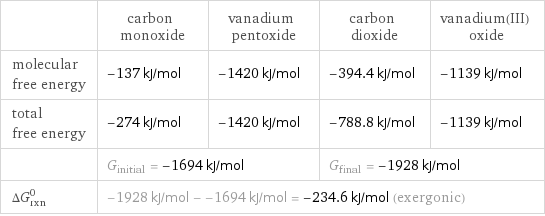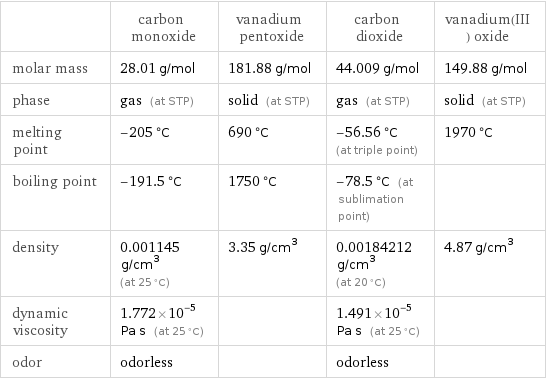Input interpretation

CO carbon monoxide + V_2O_5 vanadium pentoxide ⟶ CO_2 carbon dioxide + V_2O_3 vanadium(III) oxide
Balanced equation

Balance the chemical equation algebraically: CO + V_2O_5 ⟶ CO_2 + V_2O_3 Add stoichiometric coefficients, c_i, to the reactants and products: c_1 CO + c_2 V_2O_5 ⟶ c_3 CO_2 + c_4 V_2O_3 Set the number of atoms in the reactants equal to the number of atoms in the products for C, O and V: C: | c_1 = c_3 O: | c_1 + 5 c_2 = 2 c_3 + 3 c_4 V: | 2 c_2 = 2 c_4 Since the coefficients are relative quantities and underdetermined, choose a coefficient to set arbitrarily. To keep the coefficients small, the arbitrary value is ordinarily one. For instance, set c_2 = 1 and solve the system of equations for the remaining coefficients: c_1 = 2 c_2 = 1 c_3 = 2 c_4 = 1 Substitute the coefficients into the chemical reaction to obtain the balanced equation: Answer: | | 2 CO + V_2O_5 ⟶ 2 CO_2 + V_2O_3
Structures

+ ⟶ +
Names

carbon monoxide + vanadium pentoxide ⟶ carbon dioxide + vanadium(III) oxide
Reaction thermodynamics
Enthalpy

| carbon monoxide | vanadium pentoxide | carbon dioxide | vanadium(III) oxide molecular enthalpy | -110.5 kJ/mol | -1551 kJ/mol | -393.5 kJ/mol | -1219 kJ/mol total enthalpy | -221 kJ/mol | -1551 kJ/mol | -787 kJ/mol | -1219 kJ/mol | H_initial = -1772 kJ/mol | | H_final = -2006 kJ/mol | ΔH_rxn^0 | -2006 kJ/mol - -1772 kJ/mol = -234.2 kJ/mol (exothermic) | | |
Gibbs free energy

| carbon monoxide | vanadium pentoxide | carbon dioxide | vanadium(III) oxide molecular free energy | -137 kJ/mol | -1420 kJ/mol | -394.4 kJ/mol | -1139 kJ/mol total free energy | -274 kJ/mol | -1420 kJ/mol | -788.8 kJ/mol | -1139 kJ/mol | G_initial = -1694 kJ/mol | | G_final = -1928 kJ/mol | ΔG_rxn^0 | -1928 kJ/mol - -1694 kJ/mol = -234.6 kJ/mol (exergonic) | | |
Equilibrium constant
![Construct the equilibrium constant, K, expression for: CO + V_2O_5 ⟶ CO_2 + V_2O_3 Plan: • Balance the chemical equation. • Determine the stoichiometric numbers. • Assemble the activity expression for each chemical species. • Use the activity expressions to build the equilibrium constant expression. Write the balanced chemical equation: 2 CO + V_2O_5 ⟶ 2 CO_2 + V_2O_3 Assign stoichiometric numbers, ν_i, using the stoichiometric coefficients, c_i, from the balanced chemical equation in the following manner: ν_i = -c_i for reactants and ν_i = c_i for products: chemical species | c_i | ν_i CO | 2 | -2 V_2O_5 | 1 | -1 CO_2 | 2 | 2 V_2O_3 | 1 | 1 Assemble the activity expressions accounting for the state of matter and ν_i: chemical species | c_i | ν_i | activity expression CO | 2 | -2 | ([CO])^(-2) V_2O_5 | 1 | -1 | ([V2O5])^(-1) CO_2 | 2 | 2 | ([CO2])^2 V_2O_3 | 1 | 1 | [V2O3] The equilibrium constant symbol in the concentration basis is: K_c Mulitply the activity expressions to arrive at the K_c expression: Answer: | | K_c = ([CO])^(-2) ([V2O5])^(-1) ([CO2])^2 [V2O3] = (([CO2])^2 [V2O3])/(([CO])^2 [V2O5])](../image_source/dfe3fdb4d865dca79cac7aad63af1be2.png)
Construct the equilibrium constant, K, expression for: CO + V_2O_5 ⟶ CO_2 + V_2O_3 Plan: • Balance the chemical equation. • Determine the stoichiometric numbers. • Assemble the activity expression for each chemical species. • Use the activity expressions to build the equilibrium constant expression. Write the balanced chemical equation: 2 CO + V_2O_5 ⟶ 2 CO_2 + V_2O_3 Assign stoichiometric numbers, ν_i, using the stoichiometric coefficients, c_i, from the balanced chemical equation in the following manner: ν_i = -c_i for reactants and ν_i = c_i for products: chemical species | c_i | ν_i CO | 2 | -2 V_2O_5 | 1 | -1 CO_2 | 2 | 2 V_2O_3 | 1 | 1 Assemble the activity expressions accounting for the state of matter and ν_i: chemical species | c_i | ν_i | activity expression CO | 2 | -2 | ([CO])^(-2) V_2O_5 | 1 | -1 | ([V2O5])^(-1) CO_2 | 2 | 2 | ([CO2])^2 V_2O_3 | 1 | 1 | [V2O3] The equilibrium constant symbol in the concentration basis is: K_c Mulitply the activity expressions to arrive at the K_c expression: Answer: | | K_c = ([CO])^(-2) ([V2O5])^(-1) ([CO2])^2 [V2O3] = (([CO2])^2 [V2O3])/(([CO])^2 [V2O5])
Rate of reaction
![Construct the rate of reaction expression for: CO + V_2O_5 ⟶ CO_2 + V_2O_3 Plan: • Balance the chemical equation. • Determine the stoichiometric numbers. • Assemble the rate term for each chemical species. • Write the rate of reaction expression. Write the balanced chemical equation: 2 CO + V_2O_5 ⟶ 2 CO_2 + V_2O_3 Assign stoichiometric numbers, ν_i, using the stoichiometric coefficients, c_i, from the balanced chemical equation in the following manner: ν_i = -c_i for reactants and ν_i = c_i for products: chemical species | c_i | ν_i CO | 2 | -2 V_2O_5 | 1 | -1 CO_2 | 2 | 2 V_2O_3 | 1 | 1 The rate term for each chemical species, B_i, is 1/ν_i(Δ[B_i])/(Δt) where [B_i] is the amount concentration and t is time: chemical species | c_i | ν_i | rate term CO | 2 | -2 | -1/2 (Δ[CO])/(Δt) V_2O_5 | 1 | -1 | -(Δ[V2O5])/(Δt) CO_2 | 2 | 2 | 1/2 (Δ[CO2])/(Δt) V_2O_3 | 1 | 1 | (Δ[V2O3])/(Δt) (for infinitesimal rate of change, replace Δ with d) Set the rate terms equal to each other to arrive at the rate expression: Answer: | | rate = -1/2 (Δ[CO])/(Δt) = -(Δ[V2O5])/(Δt) = 1/2 (Δ[CO2])/(Δt) = (Δ[V2O3])/(Δt) (assuming constant volume and no accumulation of intermediates or side products)](../image_source/c6b78a5c96f2f8dc799198b73f4ca17a.png)
Construct the rate of reaction expression for: CO + V_2O_5 ⟶ CO_2 + V_2O_3 Plan: • Balance the chemical equation. • Determine the stoichiometric numbers. • Assemble the rate term for each chemical species. • Write the rate of reaction expression. Write the balanced chemical equation: 2 CO + V_2O_5 ⟶ 2 CO_2 + V_2O_3 Assign stoichiometric numbers, ν_i, using the stoichiometric coefficients, c_i, from the balanced chemical equation in the following manner: ν_i = -c_i for reactants and ν_i = c_i for products: chemical species | c_i | ν_i CO | 2 | -2 V_2O_5 | 1 | -1 CO_2 | 2 | 2 V_2O_3 | 1 | 1 The rate term for each chemical species, B_i, is 1/ν_i(Δ[B_i])/(Δt) where [B_i] is the amount concentration and t is time: chemical species | c_i | ν_i | rate term CO | 2 | -2 | -1/2 (Δ[CO])/(Δt) V_2O_5 | 1 | -1 | -(Δ[V2O5])/(Δt) CO_2 | 2 | 2 | 1/2 (Δ[CO2])/(Δt) V_2O_3 | 1 | 1 | (Δ[V2O3])/(Δt) (for infinitesimal rate of change, replace Δ with d) Set the rate terms equal to each other to arrive at the rate expression: Answer: | | rate = -1/2 (Δ[CO])/(Δt) = -(Δ[V2O5])/(Δt) = 1/2 (Δ[CO2])/(Δt) = (Δ[V2O3])/(Δt) (assuming constant volume and no accumulation of intermediates or side products)
Chemical names and formulas

| carbon monoxide | vanadium pentoxide | carbon dioxide | vanadium(III) oxide formula | CO | V_2O_5 | CO_2 | V_2O_3 Hill formula | CO | O_5V_2 | CO_2 | O_3V_2 name | carbon monoxide | vanadium pentoxide | carbon dioxide | vanadium(III) oxide
Substance properties

| carbon monoxide | vanadium pentoxide | carbon dioxide | vanadium(III) oxide molar mass | 28.01 g/mol | 181.88 g/mol | 44.009 g/mol | 149.88 g/mol phase | gas (at STP) | solid (at STP) | gas (at STP) | solid (at STP) melting point | -205 °C | 690 °C | -56.56 °C (at triple point) | 1970 °C boiling point | -191.5 °C | 1750 °C | -78.5 °C (at sublimation point) | density | 0.001145 g/cm^3 (at 25 °C) | 3.35 g/cm^3 | 0.00184212 g/cm^3 (at 20 °C) | 4.87 g/cm^3 dynamic viscosity | 1.772×10^-5 Pa s (at 25 °C) | | 1.491×10^-5 Pa s (at 25 °C) | odor | odorless | | odorless |
Units
